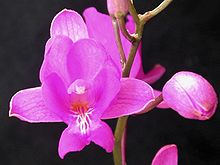
In the botanical classification of plants, Aeridinae Pfitzer is a subtribe of the tribe Vandeae whose representatives all have a monopodial growth habit and do not possess pseudobulbs.

The taxonomy of the Orchidaceae (orchid family) has evolved slowly during the last 250 years, starting with Carl Linnaeus who in 1753 recognized eight genera. De Jussieu recognized the Orchidaceae as a separate family in his Genera Plantarum in 1789. Olof Swartz recognized 25 genera in 1800. Louis Claude Richard provided us in 1817 with the descriptive terminology of the orchids. (See External links below). The next step was taken in 1830-1840 by John Lindley, who recognized four subfamilies. He is generally recognized as the father of orchid taxonomy. The next important step was taken by George Bentham with a new classification, recognizing subtribes for the first time. This classification was first presented in a paper that Bentham read to the Royal Society in 1881. Then it was published in 1883 in the final volume of Genera Plantarum. The next great contributors were Pfitzer (1887), Schlechter (1926), Mansfeld (1937), Dressler and Dodson (1960), Garay (1960, 1972), Vermeulen (1966), again Dressler (1981). and Burns-Balogh and Funk (1986). Dressler's 1993 book had considerable influence on later work.

The Orchidoideae, or the orchidoid orchids, are a subfamily of the orchid family (Orchidaceae) that contains around 3630 species. Species typically have a single (monandrous), fertile anther which is erect and basitonic.
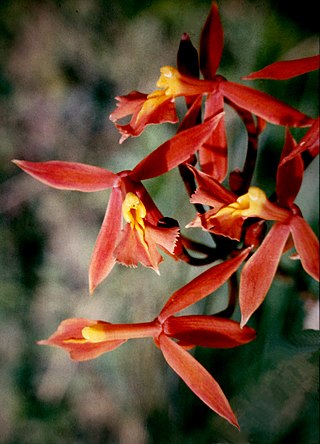
Epidendroideae is a subfamily of plants in the orchid family, Orchidaceae. Epidendroideae is larger than all the other orchid subfamilies together, comprising more than 15,000 species in 576 genera. Most epidendroid orchids are tropical epiphytes, typically with pseudobulbs. There are, however, some terrestrials such as Epipactis and even a few myco-heterotrophs, which are parasitic upon mycorrhizal fungi.

Acrorchis is a monotypic genus from the orchid family (Orchidaceae), subfamily Epidendroideae, tribe Epidendreae, subtribe Laeliinae.

Coelia is a genus of orchids. It had previously been tentatively classified as the only genus of the subtribe Coeliinae of the tribe Epidendreae.
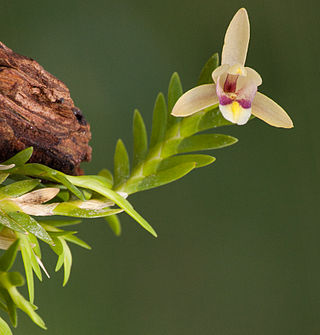
Adrorhizinae is an orchid subtribe in the tribe Vandeae.

Laeliinae is a Neotropical subtribe including 40 orchid genera, such as Brassavola, Laelia and Cattleya. The genus Epidendrum is the largest within this subtribe, containing about 1500 species. This is followed by the genus Encyclia, with over 120 species.
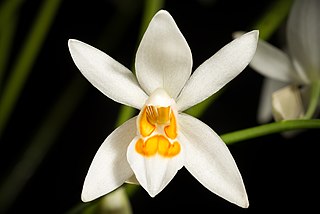
Arethuseae is a mid-sized tribe of orchids in the subfamily Epidendroideae. This tribe was initially categorized by John Lindley in 1840. Its largest subtribes are Arethusinae and Coelogyninae.
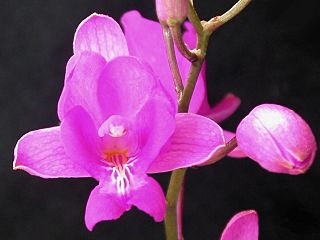
Bletiinae is a small-sized subtribe of orchids in the tribe Epidendreae of the subfamily Epidendroideae.

The Vandeae is a large monophyletic tribe within the family of orchids.
Risleya is a monotypic genus of flowering plants from the orchid family, Orchidaceae. The sole species is Risleya atropurpurea. It is native to the Himalayas of Sichuan, Tibet, Yunnan, Bhutan, India, Sikkim, Assam and Myanmar. It was previously included in the subtribe Malaxidinae but is now placed in the tribe Collabieae.

Angraecinae is a subtribe in the family Orchidaceae. The subtribe consists of approximately 47 genera. The type genus is Angraecum. Most of the genera are endemic to Africa, Madagascar and other Indian Ocean Islands, a few genera can also be found in the Americas.
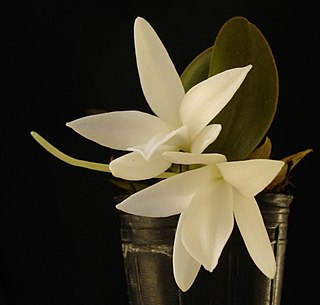
Aerangidinae is classified as a subtribe within the tribe Vandeae in the family Orchidaceae. However, it is likely to soon become a synonym of Angraecinae with the genera below re-allocated to this sub-tribe. As traditionally circumscribed, it consists of 36 genera and about 300 species. The type genus of this subtribe is Aerangis. Members of this group are epiphytic orchids having a monopodial habit and are endemic to tropical Africa and Madagascar. They are distinguished from the other subtribes in Vandeae by having an elongate rostellum, an elongate spur, and two pollinia. Most genera in the group indicate pollination by moths, however leaf beetles are reported as frequent visitors, but it is unknown whether they are vectors for pollination.

Polystachyinae is a subtribe within the tribe Vandeae in family Orchidaceae. It consists of 2 genera and about 228 known species. The type genus of this subtribe is Polystachya. The group is pantropical, being native to tropical Africa primarily, but also to tropical America. Members of this group are epiphytic and are distinguished from the other subtribes in the tribe Vandeae by their sympodial growth habit and the presence of four pollinia. Pollination is mostly by small species of bees, however some species exhibit auto-pollination.

Dendrobieae is a tribe in the subfamily Epidendroideae, in the family Orchidaceae. The Dendrobieae are mostly tropical, epiphytic orchids which contain pseudobulbs.

The Coelogyninae are an orchid subtribe in the tribe Arethuseae.

Calypsoinae is an orchid subtribe in the tribe Epidendreae of subfamily Epidendroideae. It has previously been recognized as tribe Calypsoeae in the subfamily Epidendroideae.
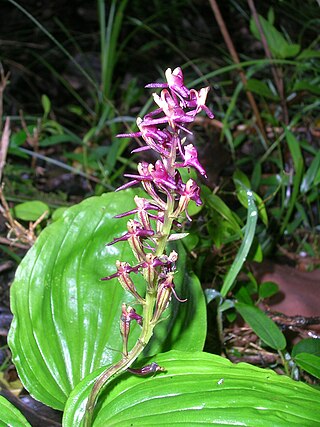
Malaxideae is an orchid tribe in the subfamily Epidendroideae.

Neottieae is an orchid tribe in the subfamily Epidendroideae. It contains six genera and over 200 species distributed mainly in temperate and subtropical zones of the northern hemisphere. All its members are terrestrial plants, hinting at an early branching with Epidendroideae which is largely an epiphytic group. Neottieae is likely to be the result of a single temperate radiation of epidendroids, although it appears that some lineages in this tribe have crept back into the tropics.
